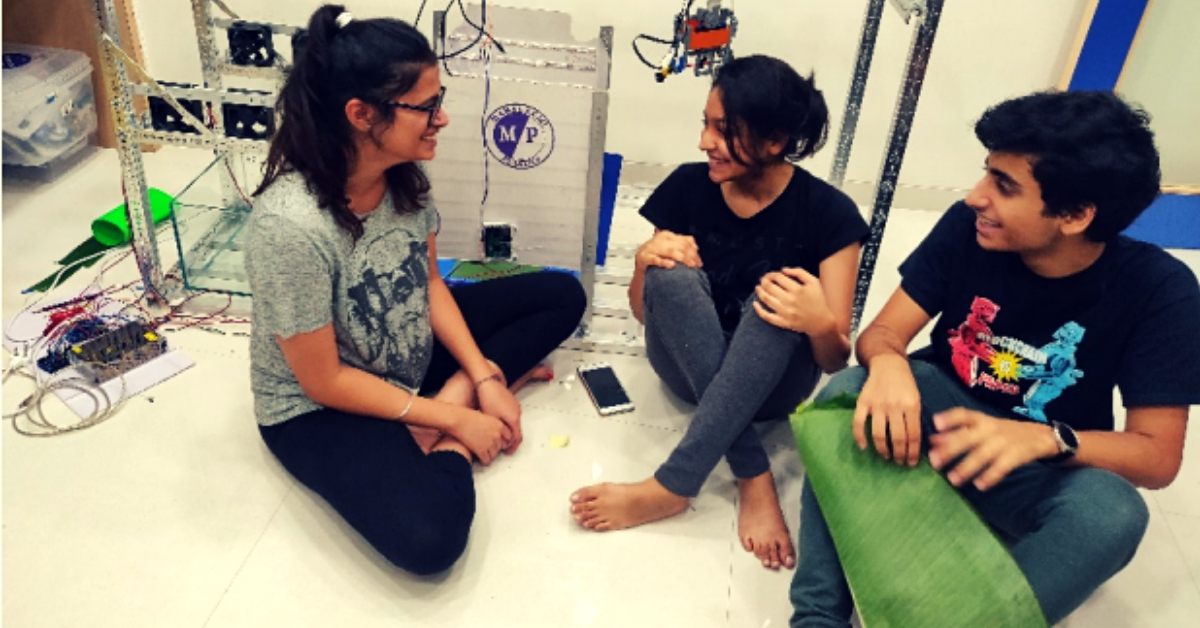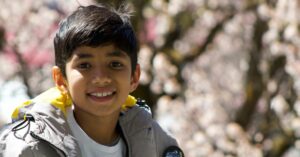Exclusive: Mumbai Kids Build Unique Machine That Turns Banana Leaf Into Food Packaging!
EverGreen is cost-efficient as a metre of banana leaf costs about Rs 5, while plastic and aluminium foil cost anywhere between Rs 40 to Rs 60 per metre.

#ChildrenForThePlanet: This Children’s Day, TBI will be celebrating young innovators who are taking steps big and small for a sustainable future.
The doorbell rings. And the aroma of piping hot food wafts through the air.
Food delivered to your doorstep is always a delight, right?
But how many times do we closely observe the potential health threats we welcome into our homes with these deliveries?
No, we are not talking about the food’s nutritive value but the packaging it comes in.
Plastic cutlery, newspaper packaging, or even aluminium foil not only cause health hazards but also hamper food security. While the aluminium from the foil leaching into your hot food is said to cause Alzheimer’s and kidney ailments, plastic and ink from newspapers are carcinogenic.
But an award-winning team of 16-year-olds from Mumbai has found an alternative.
In the age-old banana leaf!

Whether it is serving Kerala’s traditional sadhya (a feast of traditional vegetarian dishes) or steaming the Mangaluru delicacy pathrode (made from roasted colocasia leaves, stuffed with rice flour and flavourings such as spices, tamarind and jaggery), the banana leaf has been an intrinsic part of Indian culture.
The students at the city-based On My Own Technology (OMOTEC) Institute, have leveraged these qualities of the locally-available and financially viable leaves to develop a unique packaging solution.
Christened EverGreen, they have built a prototype of a packaging machine that not only secures food hygiene but also has the power to ensure additional income to farmers.
Attention young innovators! India’s biggest youth innovation challenge is here. Atal Innovation Mission, NITI Aayog & The Better India present Innovation Marathon 2018 — a nation-wide challenge open to those under the age of 18 with innovations that can solve some of India’s most pressing issues. The top 30 innovations will win a chance to attend a Student Innovator Program other than getting cash prizes, mentorship and opportunities to develop their prototypes further.
Have an innovation?
Unable to view the above button? Click here
In an exclusive interview with The Better India, the team of 16-year-olds Vanishree Iyer, Shreya Agrawal and Riyaan Bakhda explain their technology.
The EverGreen prototype
“The prototype that we have built follows a multistage process to complete the packaging. From cutting the leaf, to scanning it for safety, followed by boiling, drying, sterilising and folding, it does it all,” says Vanishree.
The current prototype that they have built uses five lego EV3 bricks, one Arduino Uno (microcontroller board) and one Raspberry Pi (credit-card sized computer) which
communicate using USB daisy chain (a type of wiring system) and Bluetooth to enable the full model to function as a single autonomous unit.
Working

The process begins with you placing a banana leaf on to the cutting apparatus, which cuts it into rectangular pieces of fixed sizes by slicing the surface using blades. A rack-and-pinion mechanism ensures that the blades are moved, lowered and raised accurately.
Once cut, the EV3 brick on the rover is wirelessly alerted to pick the leaf up and carry it to the next stage, which is scanning.
In this process, the leaf is placed in front of a camera connected to the Raspberry Pi. This scans an image using an Image Processing Algorithm written in Python (a coding language), which detects and highlights any suspicious patterns or discolouration on the leaf’s surface.
The feature detection algorithm identifies if a leaf is diseased or safe to be used in packaging. The final results are sensed by the rover through its colour sensor. If the leaf is diseased, it is disposed of in the bin, and the rover gets back to its original position. But if the leaf is safe to use, then it is lowered into a water bath.
“Although raw banana leaves are susceptible to wear-and-tear, we found that once heated at approximately 65-degrees Celsius, they become durable and flexible,” says Riyaan Bakhda.
Once the leaf is boiled for 30 seconds, it is kept in front of four Hot-Air-Fans that dry them. It is then sterilised using UV lights to eliminate any dormant microbial or fungal life which can potentially contaminate the food.
The leaf is then placed on a lego folding mechanism which is connected via USB Daisy Chain. Once you place the food on the leaf, the mechanism closes its flaps and secures it with an elastic rubber band. Your food is now safely packaged and ready to go!
Read More: #ChildrenForThePlanet: 12-YO Pune Boy’s Innovation Can Rid Our Oceans of Plastic
Advantages of the packaging
EverGreen is cost-efficient as a metre of banana leaf costs about Rs 5, while plastic and aluminium foil cost anywhere between Rs 40 to Rs 60 per metre.
“Also during our three-month research, we figured how banana leaf packaging could be a good source of additional income to farmers. In most cases, the farmers dispose of the banana plantation after it bears fruit only once a year. Shockingly, 106 million tonnes of banana leaves are wasted each year. So the method could be a great way to give this food waste a new lease of life, while also avoiding health and environmental hazards,” says Shreya Agrawal.
Apart from the medicinal banana leaf, the team is also exploring the use of other leaves like lotus and teak for packaging. The plan is to make the model more compact and customise the packaging by folding the leaves in various shapes and sizes.
The prototype was built over six months by the students with funds to the tune of Rs 40,000 raised by their own families. And the end-to-end support was provided by their institute OMOTEC, which helps young minds explore and build prototype solutions for community-based problems using robotics and innovation.
“Our families and OMOTEC have been our greatest support through the research and the execution of the project. They believed in our vision and helped us put our best foot forward,” the talented youngsters shared.
Deserving to be called ‘Children for the Planet’, they sign off by saying,
“If you know there is a problem, take a stand. Don’t give up. We saw an issue and decided not to walk away. Instead, we decided to find a solution. You can do that too. It is only when children unite that we will be able to find innovative solutions to everyday problems that stare at us in the eye.”
The team won the first place at the national edition of the World Robotics Olympiad where they were pitted against 36 teams from across the country. They are now travelling to Thailand for the global finale of the Olympiad where they will compete against 86 countries.
Attention young innovators! India’s biggest youth innovation challenge is here. Atal Innovation Mission, NITI Aayog & The Better India present Innovation Marathon 2018 — a nation-wide challenge open to those under the age of 18 with innovations that can solve some of India’s most pressing issues. The top 30 innovations will win a chance to attend a Student Innovator Program other than getting cash prizes, mentorship and opportunities to develop their prototypes further.
Have an innovation?
Unable to view the above button? Click here
We hope their vision and hard work bears good fruit and they bring the winner’s trophy home!
(Edited by Shruti Singhal)
Like this story? Or have something to share?
Write to us: [email protected]
Connect with us on Facebook and Twitter.
If you found our stories insightful, informative, or even just enjoyable, we invite you to consider making a voluntary payment to support the work we do at The Better India. Your contribution helps us continue producing quality content that educates, inspires, and drives positive change.
Choose one of the payment options below for your contribution-
By paying for the stories you value, you directly contribute to sustaining our efforts focused on making a difference in the world. Together, let's ensure that impactful stories continue to be told and shared, enriching lives and communities alike.
Thank you for your support. Here are some frequently asked questions you might find helpful to know why you are contributing?


This story made me
-
97
-
121
-
89
-
167














